Validation of Novel Ultrasonic Phased Array Borehole Probe by Using Simulation and Measurement
Abstract
1. Introduction
2. Materials and Methods
2.1. Phased Array Technique
2.2. Shear Horizontal (SH) Wave
- ▪
- Velocity ratio,
- ▪
- —Transverse wave velocity in polyamide
- ▪
- —Longitudinal wave velocity in polyamide
- ▪
- azimuth angles vary between −90° to +90
2.3. Directivity Measurement
2.4. Modelling and Simulation
2.5. Delay Time Calculation
2.6. Data Acquisition
3. Results and Discussion
3.1. Directivity Measurement of SH Point Source
3.2. Validation of Second Generation Borehole Probe
3.3. Velocity Measurement of Concrete Test Specimen
3.4. Nearfield Distance Simulation of Third Generation Borehole Probe
3.5. Validation of Third Generation Borehole Probe
4. Conclusions
Author Contributions
Funding
Institutional Review Board Statement
Informed Consent Statement
Data Availability Statement
Acknowledgments
Conflicts of Interest
Appendix A. Calculated Delay Time for Individual Transducer
| 45° Focusing Beam | |
|---|---|
| For 2nd Generation Borehole Probe | |
| Element No. | Delay time in seconds |
| 1 | 0.00 |
| 2 | −1.41 × 10−5 |
| 3 | −2.78 × 10−5 |
| 4 | −4.09 × 10−5 |
| 5 | −5.36 × 10−5 |
| 6 | −6.55 × 10−5 |
| 7 | −7.67 × 10−5 |
| 8 | −8.70 × 10−5 |
| 45° Focusing Beam | |||
|---|---|---|---|
| Element No. | Delay Time in Seconds | Element No. | Delay Time in Seconds |
| 1 | 0.00 | 9 | −4.2589 × 10−5 |
| 2 | −5.34 × 10−6 | 10 | −4.7912 × 10−5 |
| 3 | −1.0647 × 10−5 | 11 | −5.3236 × 10−5 |
| 4 | −1.5971 × 10−5 | 12 | −5.856 × 10−5 |
| 5 | −2.1294 × 10−5 | 13 | −6.3883 × 10−5 |
| 6 | −2.6618 × 10−5 | 14 | −6.9207 × 10−5 |
| 7 | −3.1942 × 10−5 | 15 | −7.453 × 10−5 |
| 8 | −3.7265 × 10−5 | 16 | −7.9854 × 10−5 |
References
- Wiggenhauser, H.; Samokrutov, A.; Mayer, K.; Krause, M.; Alekhin, S.; Elkin, V. LAUS—Large Aperture Ultrasonic System—for Testing Thick Concrete Structures. Int. Symp. Non-Destr. Test. Civ. Eng. (NDT-CE) 2017, 23, B4016004. [Google Scholar]
- Maierhofer, C.; Krause, M.; Wiggenhauser, H. Non-Destructive Investigation of Sluices Using Radar and Ultrasonic Impulse Echo. In NDT & E International; Elsevier Science: Amsterdam, The Netherlands, 1998; pp. 421–427. [Google Scholar]
- Schickert, M.; Krause, M.; Müller, W. Ultrasonic Imaging of Concrete Elements Using Reconstruction by Synthetic Aperture Focusing Technique. J. Mater. Civ. Eng. 2003, 15, 235–246. [Google Scholar] [CrossRef]
- Mayer, K.; Langenberg, K.; Mayer, K.; Milmann, B.; Mielentz, F. Characterization of Reflector Types by Phase-Sensitive Ultrasonic Data Processing and Imaging. J. Nondestruct. Eval. 2008, 27, 35–45. [Google Scholar] [CrossRef]
- Effner, U.; Mielentz, F.; Niederleithinger, E.; Friedrich, C.; Mauke, R.; Mayer, K. Testing repository engineered barrier systems for cracks—A challenge. Mater. Und Werkst. 2021, 52, 19–31. [Google Scholar] [CrossRef]
- Strahlenschutz, B. Endlager Morsleben: Hintergründe, Maßnahmen und Perspektiven der Stilllegung; Bundesamt für StrahlenschutzÖffentlichkeitsarbei: Salzgitter, Germany, 2015; Available online: https://archiv.bge.de/archiv/www.endlager-morsleben.de/SharedDocs/Downloads/Morsleben/DE/broschueren/morsleben-stilllegung-neuf4b0.pdf?__blob=publicationFile&v=9 (accessed on 30 October 2022).
- Lay, V.; Baensch, F.; Johann, S.; Sturm, P.; Mielentz, F.; Prabhakara, P.; Hofmann, D.; Niederleithinger, E.; Hans-Kühne, C. SealWasteSafe: Materials Technology, Monitoring Techniques, and Quality Assurance for Safe Sealing Structures in Underground Repositories. In Safety of Nuclear Waste Disposal; Copernicus Publications: Göttingen, Germany, 2021; pp. 127–128. [Google Scholar]
- Niederleithinger, E.; Effner, U.; Behrens, M.; Smith, S.; Büttner, C.; Friedrich, C.; Mauke, R. Application of Ultrasonic Techniques for Quality Assurance of Salt Concrete Engineered Barriers: Shape, Cracks and Delamination. In Proceedings of the Modern2020 2 nd International Conference about Monitoring in Geological, Paris, France, 29 January 2019. [Google Scholar]
- Schuster, K.; Amann, F.; Yong, S.; Bossart, P.; Connolly, P. High-Resolution Mini-Seismic Methods Applied in the Mont Terri Rock Laboratory (Switzerland). Swiss J. Geosci. Suppl. 2017, 5, 213–230. [Google Scholar] [CrossRef]
- Mielentz, F.; Stolpe, H.; Effner, U.; Behrens, M.; Bernstein, T.; Niederleithinger, E. Entwicklung einer Bohrlochsonde für Ultraschalluntersuchungen an Abschlussbauwerken in Endlagern. In DGZFP Anual Conference 2021; DGZFP: Berlin, Germany, 2021. [Google Scholar]
- Mayer, K.; Krause, M.; Wiggenhauser, H.; Milmann, B. Investigations for the improvement of SAFT imaging quality of a large aperture ultrasonic system. In International Symposium Non-Destructive Testing in Civil Engineering (NDT-CE) 2015; NDT.net: Berlin, Germany, 2015. [Google Scholar]
- Hossien, T.; Katrina, L.; Fereidoon, D.; Jikai, D. Phased Array Ultrasonic Technique Parametric Evaluation for Composite Materials. In Proceedings of the ASME 2014 International Mechanical Engineering Congress and Exposition, Montreal, QC, Canada, 14–20 November 2014; Volume 13. [Google Scholar]
- Krautkramer, J.; Krautkramer, H. Ultrasonic Testing of Materials; Springer: Berlin/Heidelberg, Germany; New York, NY, USA, 2009. [Google Scholar]
- Mielentz, F. Einsatzpotenzial von Laufzeitgesteuerten Ultraschall-Gruppenstrahlern an Betonbauteilen; BAM-Dissertationsreihe: Berlin, Germany, 2007; pp. 20–41. [Google Scholar]
- Maack, S. Untersuchungen zum Schallfeld niederfrequenter Ultraschallprüfköpfe für die Anwendung im Bauwesen; BAM-Dissertationsreihe: Berlin, Germany, 2013; pp. 14–161. [Google Scholar]
- Kutzner, J. Grundlagen der Ultraschallphysik; B.G Teubner Stuttgart: Stuttgart, Germany, 1983. [Google Scholar]
- Dubois, P.; Lonne, S.; Jenson, F.; Mahaut, S. Simulation of ultrasonic, eddy current and radiographic techniques within the civa software platform. In Proceedings of the 10th European Conference on Non-Destructive Testing, Moscow, Russia, 7–11 June 2010. [Google Scholar]
- Calmon, P.; Mahaut, S.; Chatillon, S.; Raillon, R. CIVA: An expertise platform for simulation and processing NDT data. In Proceedings of the Ultrasonics International and World Congress on Ultrasonics 2006, Beijing, China, 29 August–1 September 2005; Science Direct: Beijing, China, 2006. [Google Scholar]
- Schmerr, L. Time Delay Laws (2-D). In Fundamentals of Ultrasonic Phased Arrays. Solid Mechanics and Its Applications; Springier: Berlin/Heidelberg, Germany, 2015; Volume 215, p. 12. [Google Scholar]
- Langenberg, K.-J.; Marklein, R.; Mayer, K. Ultrasonic Nondestructive Testing of Materials: Theoretical Foundation; CRC Press Taylor & Francis Group: Boca Raton, FL, USA, 2012. [Google Scholar]
- Mielentz, F.; Feller, V.; Krause, M.; Orglmeister, R.; Mayer, K. Schallfeldmodellierung von Ultraschall-Transversalwellen-Prüfköpfen. Modellier. Von Prüfkopfarrays Mit Der Elastodynamischen Finiten Integr. Und Der Punktquellensynthese 2013, 55, 856–864. [Google Scholar] [CrossRef]
- Prabhakara, P.; Mielentz, F.; Stolpe, H.; Behrens, M.; Lay, V.; Niederleithinger, E. Construction and Validation of a Novel Phased Array Borehole Probe for Ultrasonic Investigations at Sealing Structures in Radioactive Repositories. In Proceedings of theInternational Symposium on Non-Destructive Testing in Civil Engineering (NDT-CE 2022), Zurich, Switzerland, 16–18 August 2022. [Google Scholar]
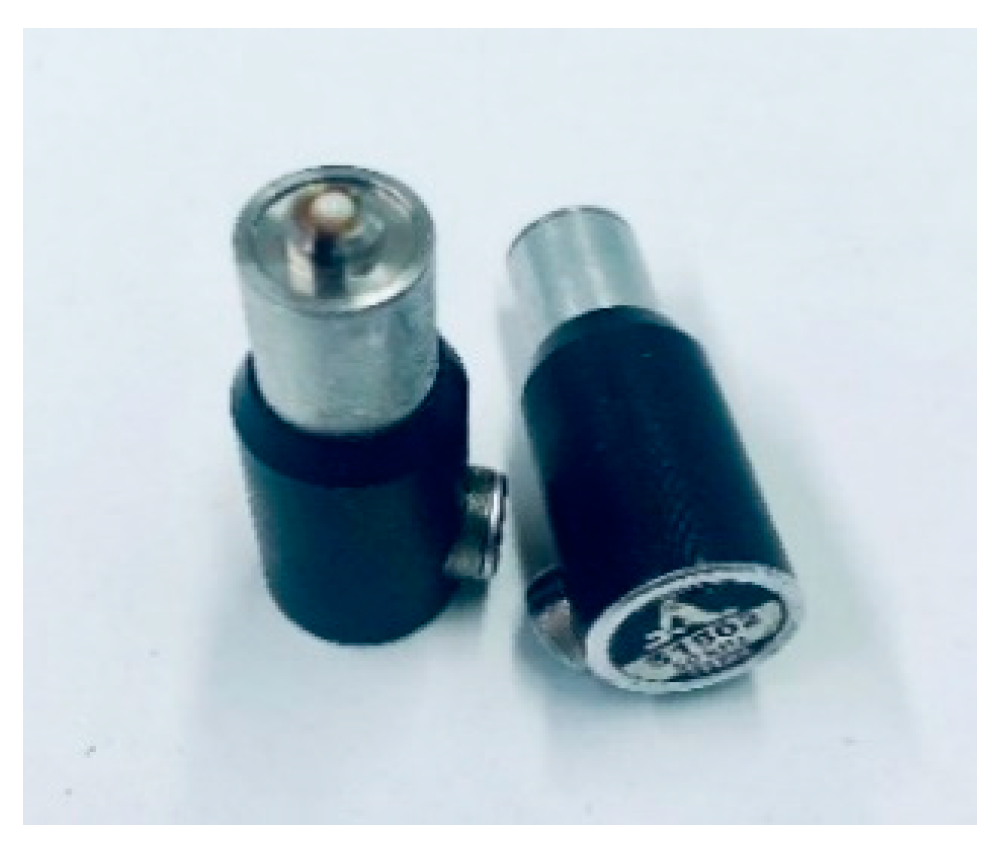


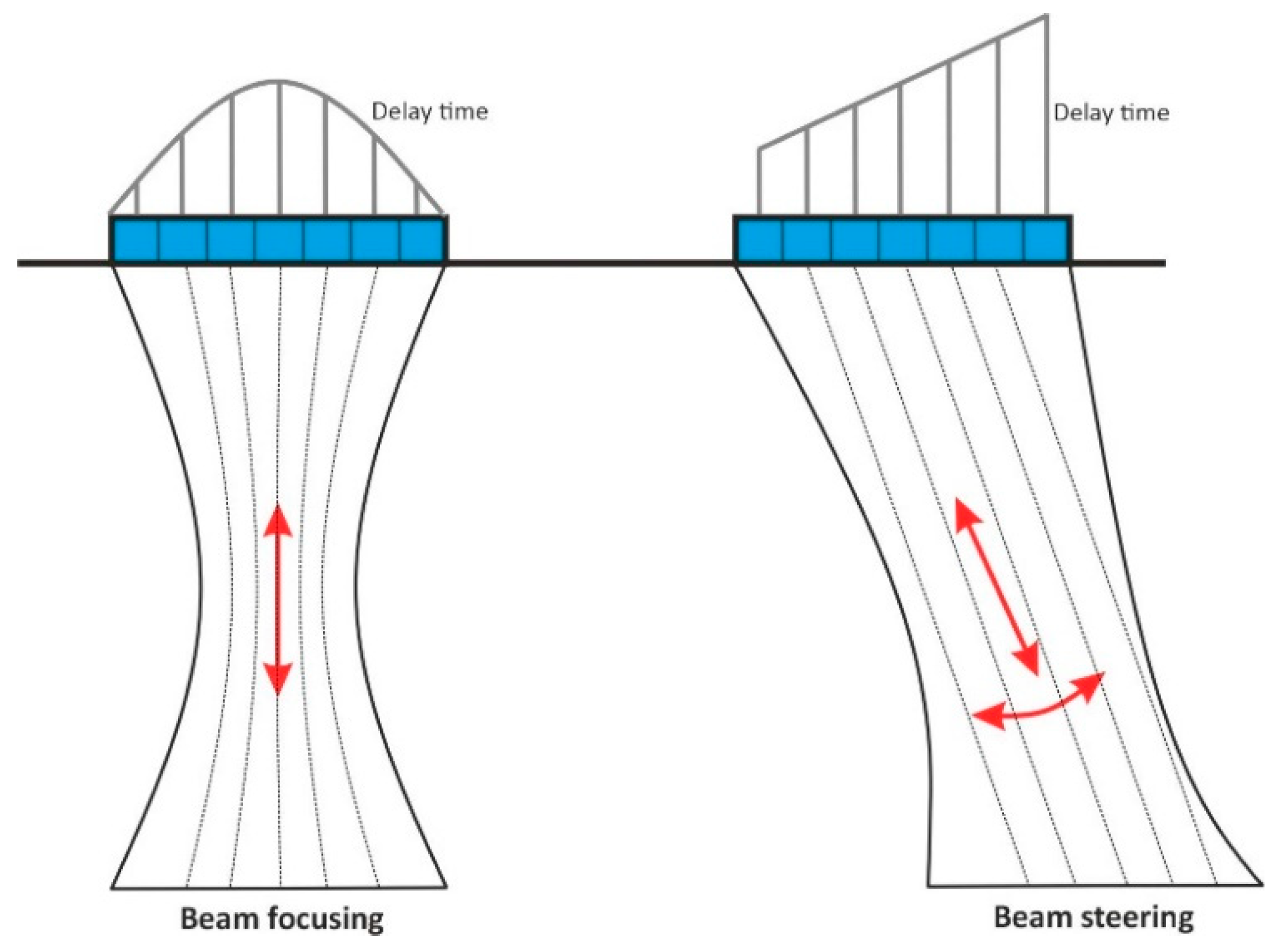
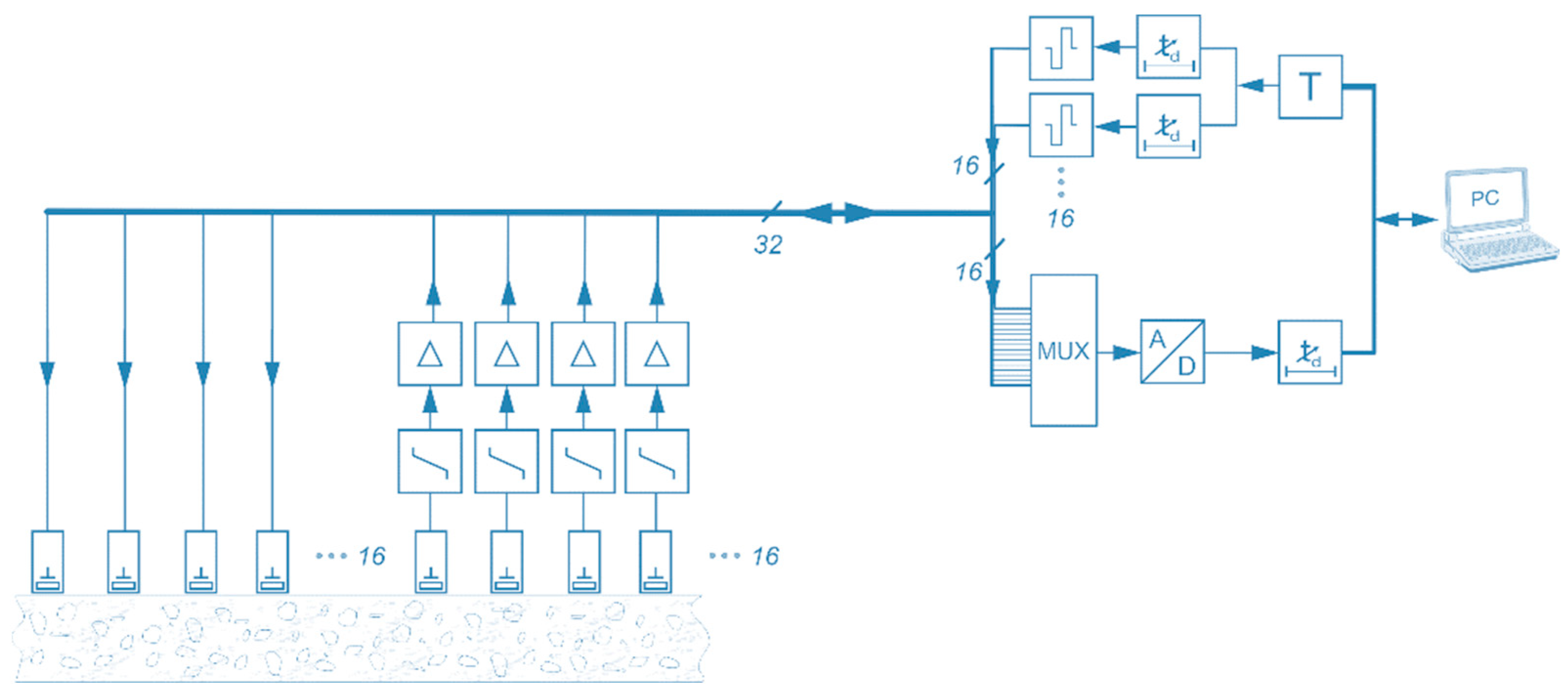
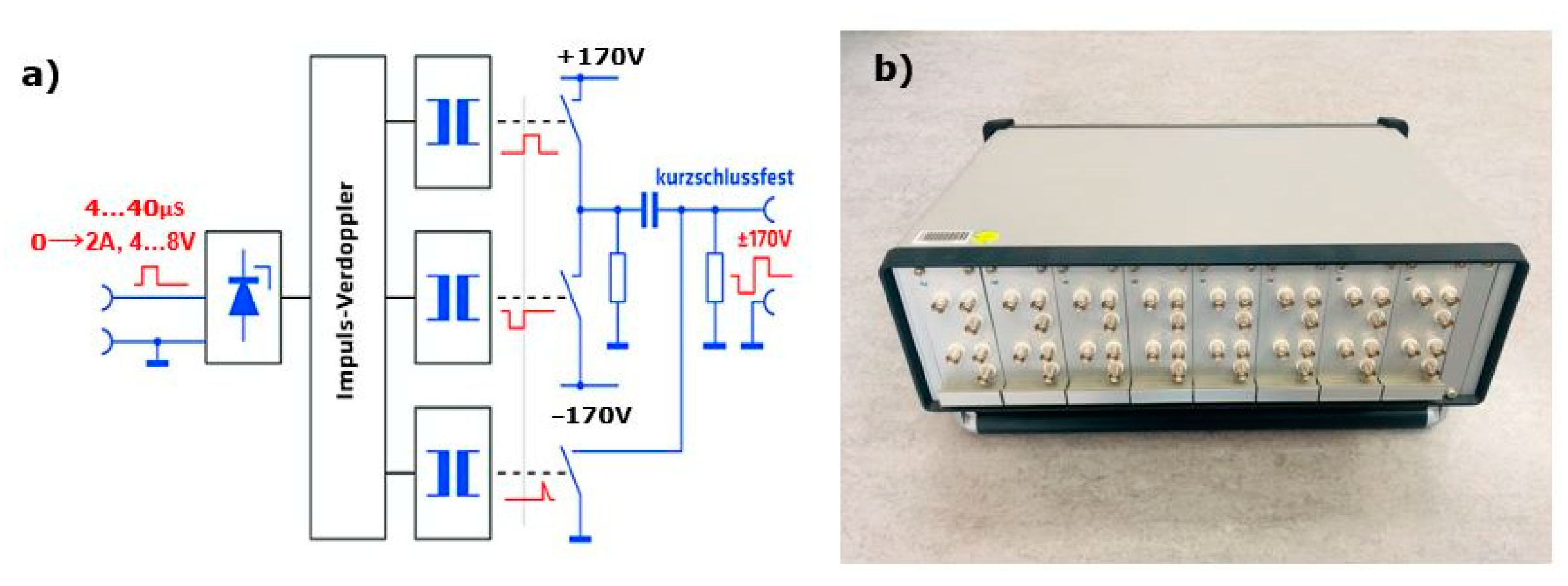





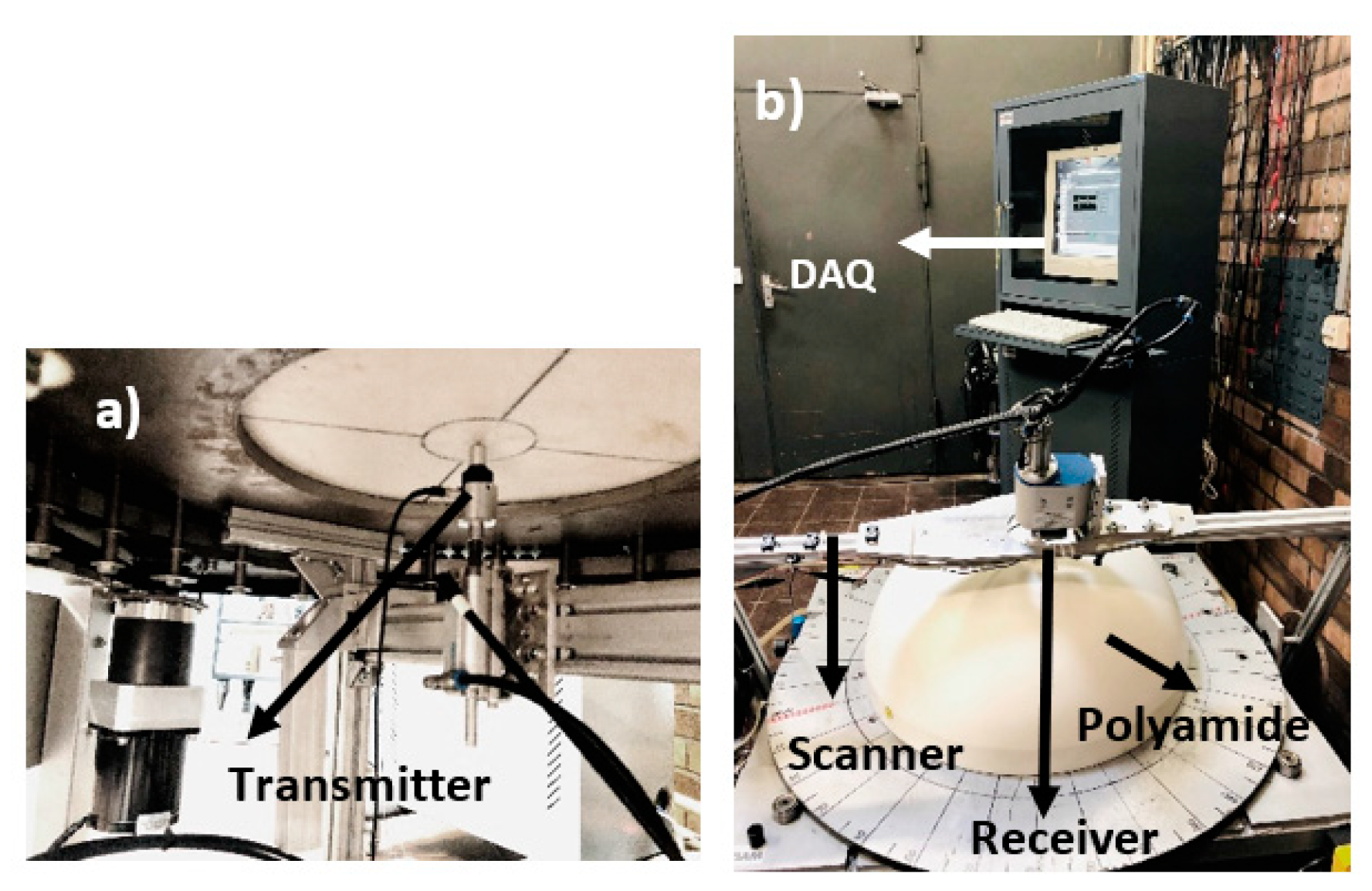
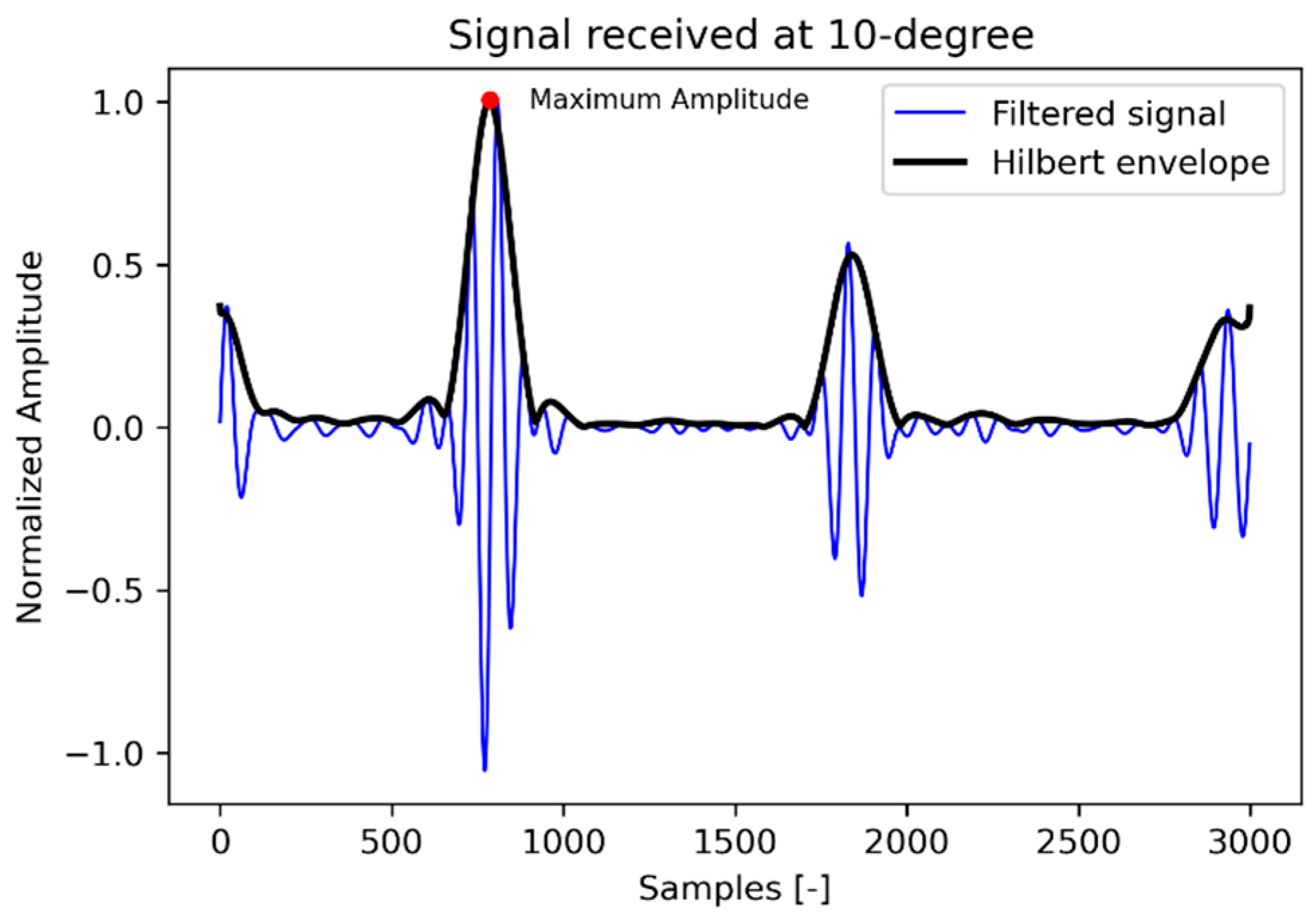


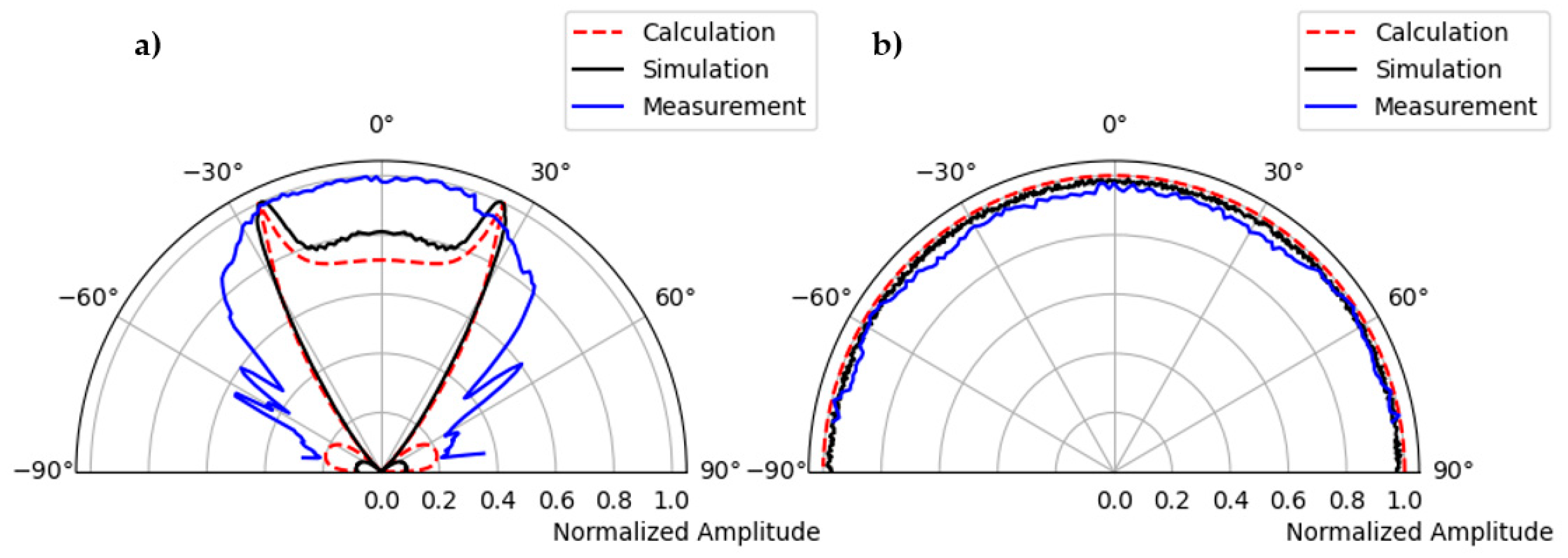
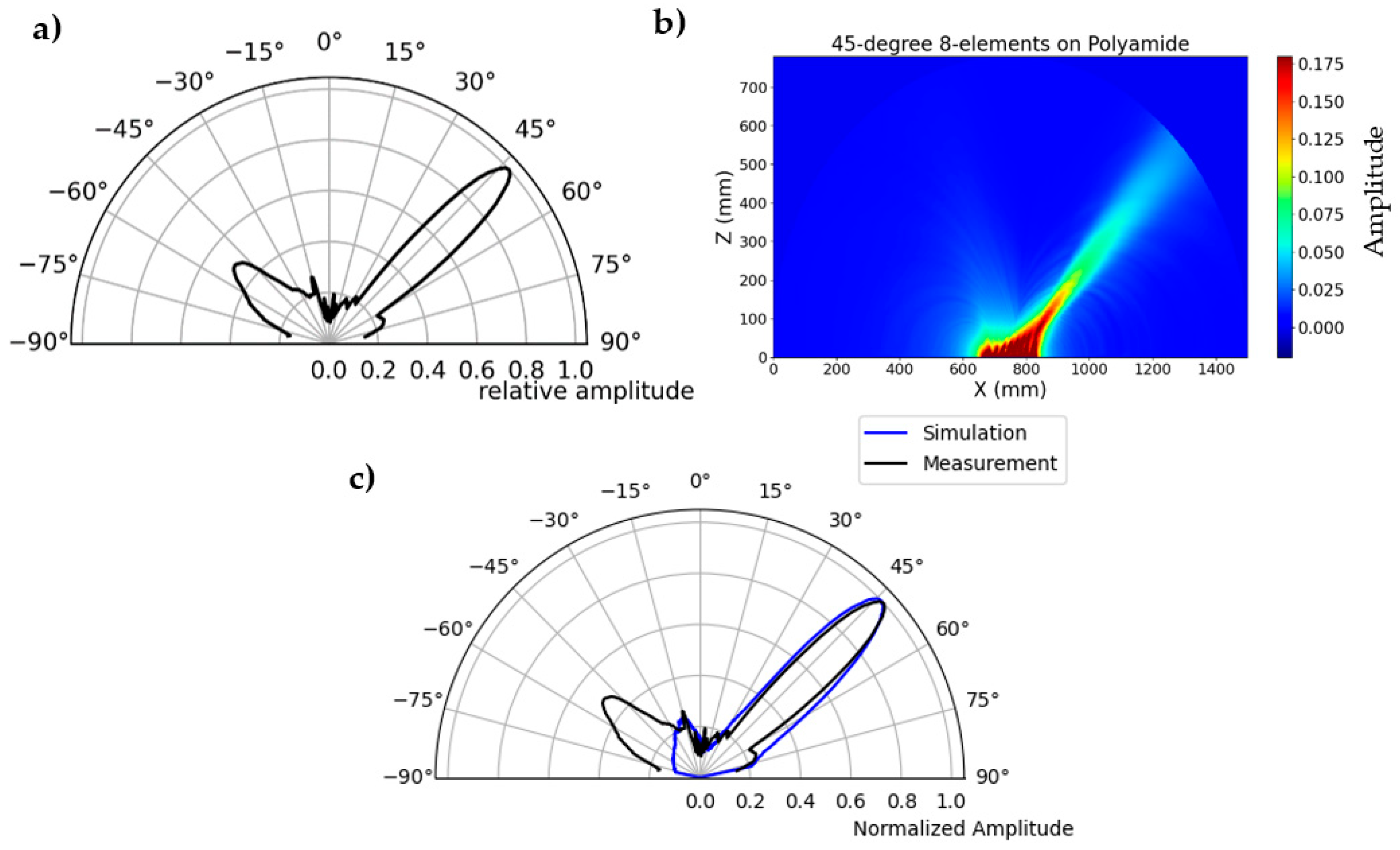


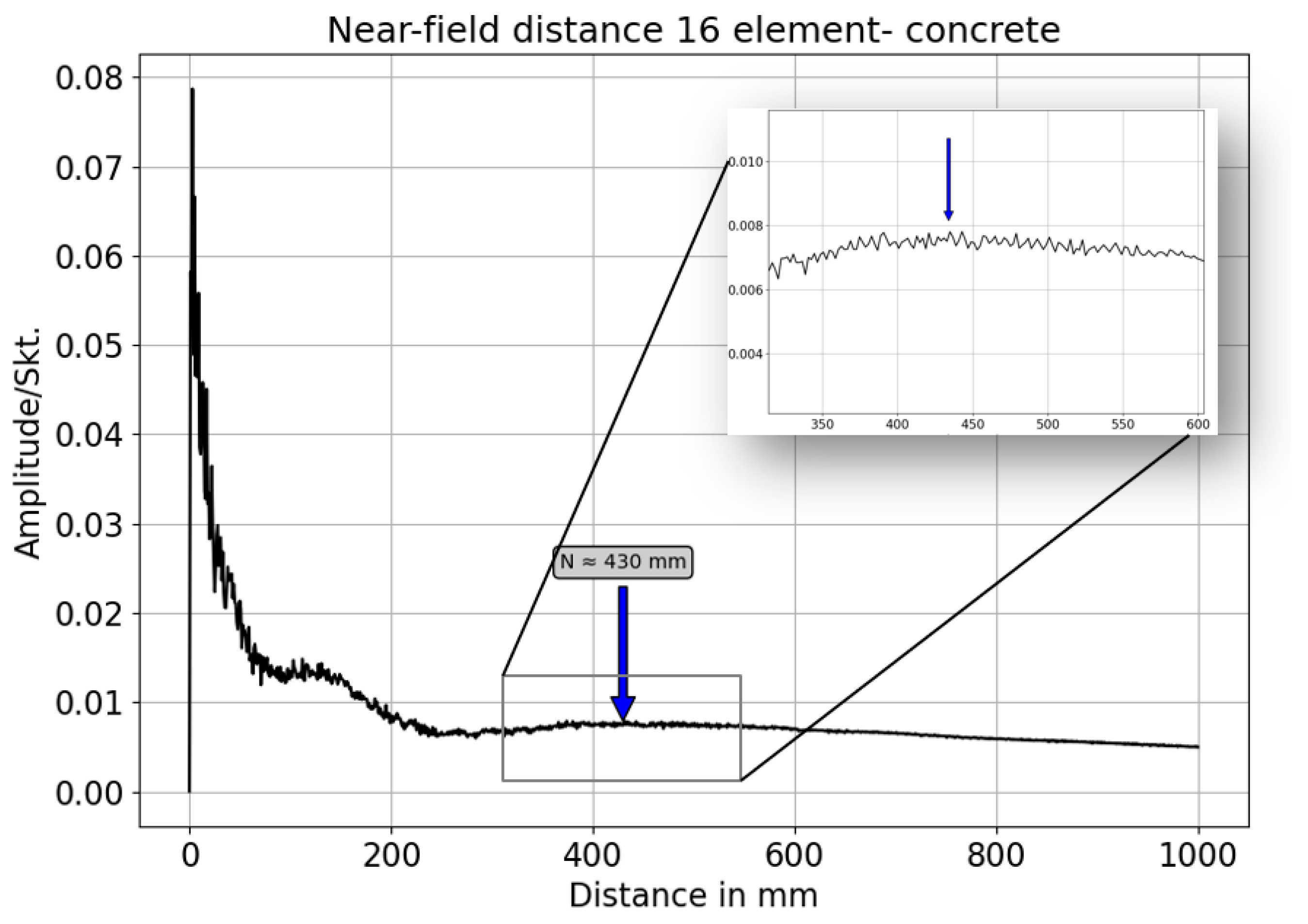
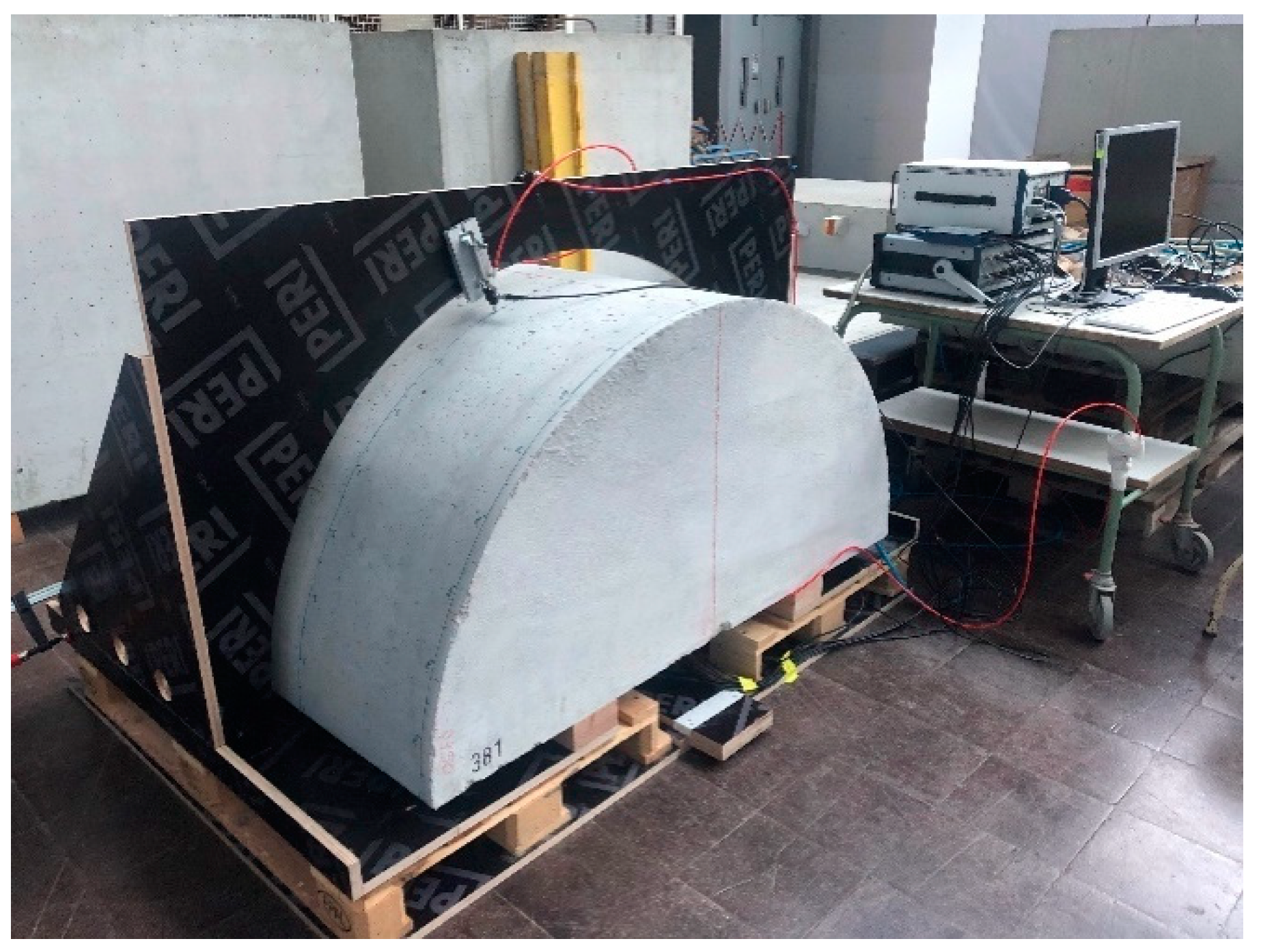

Publisher’s Note: MDPI stays neutral with regard to jurisdictional claims in published maps and institutional affiliations. |
© 2022 by the authors. Licensee MDPI, Basel, Switzerland. This article is an open access article distributed under the terms and conditions of the Creative Commons Attribution (CC BY) license (https://creativecommons.org/licenses/by/4.0/).
Share and Cite
Prabhakara, P.; Mielentz, F.; Stolpe, H.; Behrens, M.; Lay, V.; Niederleithinger, E. Validation of Novel Ultrasonic Phased Array Borehole Probe by Using Simulation and Measurement. Sensors 2022, 22, 9823. https://doi.org/10.3390/s22249823
Prabhakara P, Mielentz F, Stolpe H, Behrens M, Lay V, Niederleithinger E. Validation of Novel Ultrasonic Phased Array Borehole Probe by Using Simulation and Measurement. Sensors. 2022; 22(24):9823. https://doi.org/10.3390/s22249823
Chicago/Turabian StylePrabhakara, Prathik, Frank Mielentz, Heiko Stolpe, Matthias Behrens, Vera Lay, and Ernst Niederleithinger. 2022. "Validation of Novel Ultrasonic Phased Array Borehole Probe by Using Simulation and Measurement" Sensors 22, no. 24: 9823. https://doi.org/10.3390/s22249823
APA StylePrabhakara, P., Mielentz, F., Stolpe, H., Behrens, M., Lay, V., & Niederleithinger, E. (2022). Validation of Novel Ultrasonic Phased Array Borehole Probe by Using Simulation and Measurement. Sensors, 22(24), 9823. https://doi.org/10.3390/s22249823








